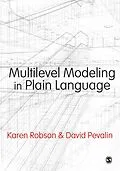Have you been told you need to do multilevel modeling, but you can't get past the forest of equations? Do you need the techniques explained with words and practical examples so they make sense?
Help is here! This book unpacks these statistical techniques in easy-to-understand language with fully annotated examples using the statistical software Stata. The techniques are explained without reliance on equations and algebra so that new users will understand when to use these approaches and how they are really just special applications of ordinary regression. Using real life data, the authors show you how to model random intercept models and random coefficient models for cross-sectional data in a way that makes sense and can be retained and repeated.
This book is the perfect answer for anyone who needs a clear, accessible introduction to multilevel modeling.
Autorentext
Karen Robson is Assistant Professor in the Department and Marketing and Hospitality at Central Michigan University. She holds a BSc (Honsd) in Psychology from Queen's University, and an MA in Psychology, an MBA and PhD from Simon Fraser University. Karen's research investigates consumer innovativeness, including how consumers repurpose or use market offerings in ways not intended by the manufacturer and the intellectual property law implications of this practice. A recipient of the Joseph-Armand Bombardier Doctoral Scholarship, her work has appeared in journals such as MIS Quarterly Executive, Business Horizons, Journal of Marketing Education, Journal of Advertising Research, and Journal of Public Affairs.
Inhalt
Chapter 1: What Is Multilevel Modeling and Why Should I Use It?
Mixing levels of analysis
Theoretical reasons for multilevel modeling
What are the advantages of using multilevel models?
Statistical reasons for multilevel modeling
Assumptions of OLS
Software
How this book is organized
Chapter 2: Random Intercept Models: When intercepts vary
A review of single-level regression
Nesting structures in our data
Getting starting with random intercept models
What do our findings mean so far?
Changing the grouping to schools
Adding Level 1 explanatory variables
Adding Level 2 explanatory variables
Group mean centring
Interactions
Model fit
What about R-squared?
R-squared?
A further assumption and a short note on random and fixed effects
Chapter 3: Random Coefficient Models: When intercepts and coefficients vary
Getting started with random coefficient models
Trying a different random coefficient
Shrinkage
Fanning in and fanning out
Examining the variances
A dichotomous variable as a random coefficient
More than one random coefficient
A note on parsimony and fitting a model with multiple random coefficients
A model with one random and one fixed coefficient
Adding Level 2 variables
Residual diagnostics
First steps in model-building
Some tasters of further extensions to our basic models
Where to next?
Chapter 4: Communicating Results to a Wider Audience
Creating journal-formatted tables
The fixed part of the model
The importance of the null model
Centring variables
Stata commands to make table-making easier
What do you talk about?
Models with random coefficients
What about graphs?
Cross-level interactions
Parting words
